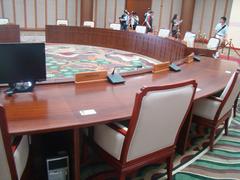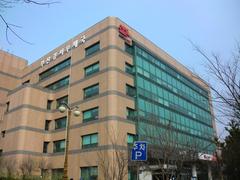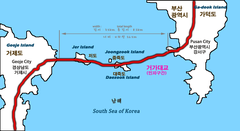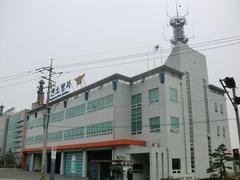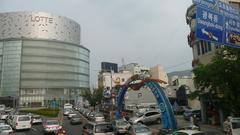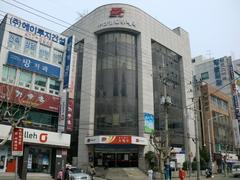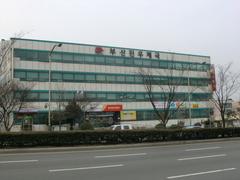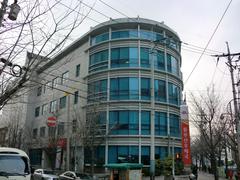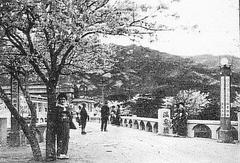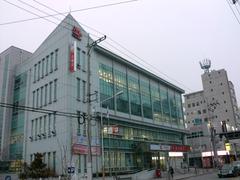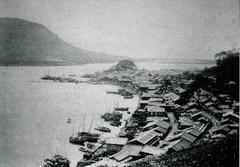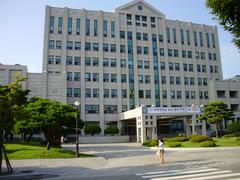Guseo Interchange Visiting Hours, Tickets, and Travel Guide: Busan Historical Sites
Date: 04/07/2025
Introduction to Guseo Interchange and Its Significance
Guseo Interchange, located in Geumjeong-gu, Busan, South Korea, is a vital transportation hub that serves as a gateway connecting Busan’s urban districts with the national expressway network. By linking the Gyeongbu Expressway—South Korea’s main north-south artery—with local roads, Guseo Interchange underpins Busan’s economic vibrance and logistical prowess. Since the Gyeongbu Expressway’s completion in 1970, the interchange has facilitated Busan’s rapid urbanization, supporting its role as the country’s largest port and a global logistics center (Namu Wiki; Invest Korea).
Guseo Interchange also provides easy access to nearby cultural and natural attractions such as Beomeosa Temple and Geumjeongsan Mountain. Its connectivity is further enhanced by proximity to Guseo Subway Station (Line 1) and multiple bus routes, making it accessible for both residents and visitors (AskAI Glarity).
With its multi-level flyovers, underpasses, and advanced traffic management systems, Guseo Interchange exemplifies modern engineering and supports Busan’s urban renewal and sustainability initiatives—crucial for future growth and hosting international events like EXPO 2030 (Breeze in Busan). This guide explores the interchange’s history, economic impact, visitor information, and nearby attractions, offering a comprehensive resource for travelers.
Table of Contents
- Discovering Guseo Interchange: History, Economic Impact, Visiting Hours & Nearby Busan Historical Sites
- Visiting Guseo Interchange: Structure, Access, and Local Attractions
- Beomeosa Temple: Hours, Tickets, and Historical Significance
- Tips for Visiting Guseo Interchange and Surroundings
- Frequently Asked Questions (FAQ)
- Visual Gallery
- Summary and Final Tips for Visiting Guseo Interchange
- References and Further Reading
Discovering Guseo Interchange: History, Economic Impact, Visiting Hours & Nearby Busan Historical Sites
Historical Context and Urban Development
Guseo Interchange (구서 나들목) is a cornerstone of Busan’s expressway network. Established on the Gyeongbu Expressway in 1970, it provided the crucial link between Seoul and Busan, catalyzing economic growth along its route (Namu Wiki). The interchange’s location in northern Busan transformed the area, connecting expanding districts to the national transportation grid and fueling modern urban growth. Historically, Busan has been a hub for diplomacy and trade since the Joseon Dynasty (Busan Metropolitan City), but post-war modernization and industrial expansion necessitated robust infrastructure—Guseo Interchange being a key component.
Strategic Location and Integration with Busan
Situated in Geumjeong-gu, Guseo Interchange lies close to academic, residential, and commercial centers, including Pusan National University. This positioning makes it vital for local mobility and regional access, linking Busan to Daegu, Ulsan, and the Gyeongsang region (AskAI Glarity).
Noteworthy Nearby Sites:
- Beomeosa Temple: A significant Buddhist temple with over a millennium of history, easily reached via local roads.
- Geumjeongsan Mountain: Offers hiking trails and panoramic vistas, accessible from the interchange.
Economic and Regional Significance
Trade and Logistics
As South Korea’s largest port city, Busan’s economy is deeply tied to its ability to move goods efficiently (Invest Korea). Guseo Interchange enables smooth freight traffic to and from Busan Port, supporting industries and exporters with its multilane design and advanced traffic systems.
Urban Growth and Competitiveness
Industrial zones, logistics centers, and educational institutions surround the interchange, making it a catalyst for job creation and investment. Urban renewal initiatives and preparations for global events like EXPO 2030 further enhance its regional importance (Breeze in Busan).
Mobility, Accessibility, and Visiting Hours
Guseo Interchange is accessible 24/7 as part of the expressway network. It supports diverse users, from logistics operators to university students, and offers seamless integration with public transit.
Nearby Attraction Hours:
- Beomeosa Temple: 6:00 AM – 6:00 PM
- Geumjeongsan Mountain Trails: Open year-round; daylight visits recommended
Navigating Guseo Interchange
- No Entry Fees: Tolls for the Gyeongbu Expressway are collected electronically; no separate tickets for the interchange.
- Signage: Bilingual (Korean/English) signs, rest areas, and nearby amenities ensure a user-friendly experience.
- Public Transit: Guseo Subway Station (Line 1) and several bus routes are within easy reach.
Visiting Guseo Interchange: Structure, Access, and Local Attractions
Physical Layout and Engineering
Guseo Interchange features a multi-level, grade-separated design with flyovers, underpasses, and loop ramps, constructed with reinforced concrete and steel (Mapcarta). It’s built to South Korean safety standards, accommodating large commercial vehicles and ensuring smooth transitions for all traffic.
Advanced electronic signage, surveillance cameras, and real-time traffic management tools are integrated with Busan’s intelligent transportation system for congestion mitigation and safety.
Accessibility and Facilities
- 24/7 Operation: The interchange is always open, with no entry restrictions.
- No Pedestrian Access: For safety, walking or cycling through the interchange is restricted, but adjacent sidewalks and local roads are available.
- Nearby Facilities: Service stations on the expressway, commercial areas, and local eateries offer restrooms, food, and essential services.
Public Transportation Integration
- Metro: Guseo Station (Line 1) is nearby, running from 5:00 AM to 11:59 PM (Rome2Rio).
- Buses: City and intercity routes serve the surrounding area, including connections to Busan Central Bus Terminal (TripSavvy).
- Taxi/Ride-hailing: Readily available for last-mile travel.
Local Highlights
- Guseo Station Area: Shopping, dining, and cultural amenities.
- Busan Al-Fatih Masjid: A symbol of the city’s cultural diversity.
- Jangjeon-dong & Allak-dong: Residential and commercial districts with authentic local experiences.
- Easy access to beaches, markets, and historic sites in Busan.
Safety and Environmental Considerations
Guseo Interchange employs crash barriers, emergency pull-off zones, and real-time monitoring for safety. Noise barriers, landscaping, and stormwater management contribute to a sustainable urban environment.
Beomeosa Temple: Hours, Tickets, and Historical Significance
Overview and History
Beomeosa Temple, founded in 678 AD, is one of Busan’s oldest and most significant Buddhist temples, known for its architectural beauty and spiritual heritage. It houses ancient pagodas, statues, and serves as an active center for Korean Buddhism.
Visiting Information
- Hours: 6:00 AM – 6:00 PM (extended during peak seasons)
- Admission: Free for temple grounds. Fees may apply for temple stay programs or special exhibitions.
- Guided Tours: Available for a nominal charge in multiple languages.
Getting There
- From Guseo Interchange: 20-minute bus or taxi ride
- By Public Transit: Metro Line 1 to Beomeosa Station, then transfer to a local bus up to the temple
Amenities
- Rest areas, tea houses, souvenir shops, and accessible restrooms
- Information centers with English-speaking staff
- Hiking trails into Geumjeongsan Mountain
Cultural Programs
- Temple Stay: Meditation, tea ceremony, monastic meals (advance booking required)
- Buddha’s Birthday and Seasonal Festivals: Lanterns, performances, and workshops
Visitor Tips
- Best Visit Times: Spring and autumn for scenic beauty
- Dress Modestly: Respect religious customs
- Accessibility: Wheelchair access at main points, though some paths are steep
- Photography: Permitted except during ceremonies
Tips for Visiting Guseo Interchange and Surroundings
- Avoid Rush Hours: Plan travel outside morning/evening peak times and weekends.
- Combine Transport Modes: Use the subway, buses, and taxis for efficient movement.
- Local Cuisine: Try specialties like milmyeon in Geumjeong-gu.
- Navigation Apps: Use KakaoMap or Naver Map for real-time directions.
- Safety: Use only designated pedestrian areas near the interchange.
Frequently Asked Questions (FAQ)
Q: Is Guseo Interchange open to the public?
A: Yes, it operates 24/7; no tickets are required, but expressway tolls apply.
Q: Are there pedestrian walkways through the interchange?
A: No, for safety reasons. Use adjacent sidewalks and local roads instead.
Q: How do I access Beomeosa Temple from Guseo Interchange?
A: Take a local bus or taxi, or use Metro Line 1 to Beomeosa Station and transfer.
Q: Are there guided tours of Guseo Interchange?
A: No official tours, but vantage points are available nearby.
Q: What are the main attractions near Guseo Interchange?
A: Beomeosa Temple, Geumjeongsan Mountain, and local shopping/dining districts.
Visual Gallery
Strategic view of Guseo Interchange, highlighting its complex road network.
The historic Beomeosa Temple, an iconic site near Guseo Interchange.
Scenic hiking trails of Geumjeongsan Mountain, accessible from the interchange.
Summary and Final Tips for Visiting Guseo Interchange
Guseo Interchange is a linchpin in Busan’s transportation infrastructure, seamlessly connecting commuters, logistics operators, and visitors to the city’s economic, academic, and cultural centers. While the interchange itself is a functional node, its strategic location near public transport and local attractions makes it a pivotal starting point for exploring Busan. For a smooth visit, plan travel outside peak hours, utilize nearby public transport, and explore the wealth of historical and natural sites nearby (Busan Metropolitan City; TripSavvy).
For up-to-date travel information and personalized itineraries, download the Audiala mobile app.
References and Further Reading
- Namu Wiki - Gyeongbu Expressway/Guseo Interchange
- Busan Metropolitan City - History of Busan
- Invest Korea - Busan Investment Overview
- Mapcarta - Guseo Interchange
- TripSavvy - Getting Around Busan
- Breeze in Busan - Busan’s 2025 Strategy
- AskAI Glarity - Significance of Busan
- Audiala App

